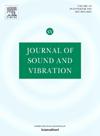由亥姆霍兹谐振器引入的环形燃烧室的广义耦合热声模态
IF 4.9
2区 工程技术
Q1 ACOUSTICS
引用次数: 0
摘要
本文研究了亥姆霍兹谐振腔对环形燃烧室热声不稳定性的影响。众所周知,环形燃烧器可以看到纯纵向热声模态,其中声场只涉及周向波数n=0的模态分量,纯旋转模态,其中声场只涉及一个(顺时针或逆时针)模态分量,具有特定的周向波数,如n=+1或- 1,常模态或混合模态,其中给定周波数的顺时针和逆时针模态分量同时存在(例如n=±1),以及倾斜模态,其中声场涉及所有三个模态分量,n=0,±1。通过采用二维低阶网络模型和三维亥姆霍兹解算器,我们首次表明,由于HR的存在,可能会产生一种广义耦合热声模式。这种类型的模态可能涉及到比倾斜模态更多的周向模态分量的耦合。我们首先使用一个无限长环形管道的分析模型来说明谐振器的特性,如其入口横截面积和阻抗,是如何影响声模态耦合的。然后使用有限长度的环形管道来表明,由于存在HR,可以产生具有这种更一般模态耦合的模态。我们还证实了HR的偏置流动马赫数和空腔体积是实现两种声学模式合并的异常点(EPs)的关键参数。我们表明,在考虑的情况下,EPs通常是广义耦合热声模式。EM2C实验室进一步研究了MICCA燃烧室的几何形状,证实了我们的发现,说明了HR在环形燃烧室中引入广义耦合热声模式的能力,以及不同HR参数对EPs的依赖性。该研究增强了对高强度模态耦合的理解,为设计先进燃气轮机燃烧室的声阻尼器提供了见解。本文章由计算机程序翻译,如有差异,请以英文原文为准。
Generalized coupled thermoacoustic modes in annular combustors introduced by Helmholtz resonators
The present work studies the impact of Helmholtz resonators (HRs) on the thermoacoustic instability in annular combustors. It has been known that annular combustors can see purely longitudinal thermoacoustic modes where the acoustic field involves only the modal component with circumferential wave number , purely spinning modes where the acoustic field involves only one (clockwise or anti-clockwise) modal component with a particular circumferential wave number such as or , standing or mixed modes where both the clockwise and anti-clockwise modal components of a given circumferential wave number coexist (such as ), and slanted modes where the acoustic field involves all three modal components with . By employing both a 2D low-order network model and a 3D Helmholtz solver, we show for the first time that a type of generalized coupled thermoacoustic modes could result due to the presence of an HR. This type of modes could involve the coupling of even more circumferential modal components than that of the slanted modes. We first use an analytical model for an infinitely long annular duct to illustrate how the resonator’s characteristics, such as its inlet cross-sectional area and impedance, influence the acoustic modal coupling. An annular duct with finite length is then used to show that modes with this more general modal coupling can result due to the presence of an HR. We also confirm the HR’s bias flow Mach number and cavity volume as pivotal parameters in achieving exceptional points (EPs), where two acoustic modes merge. We show that, in the considered cases, the EPs are usually generalized coupled thermoacoustic modes. Further study considering the geometry of the MICCA combustor from the EM2C laboratory corroborates our findings, illustrating the HR’s capability in introducing the generalized coupled thermoacoustic modes in annular combustors, and the dependence of the EPs with different HR parameters. This investigation enhances understanding of HR-induced modal coupling, providing insights for designing acoustic dampers for advanced gas turbine combustors.
求助全文
通过发布文献求助,成功后即可免费获取论文全文。
去求助
来源期刊

Journal of Sound and Vibration
工程技术-工程:机械
CiteScore
9.10
自引率
10.60%
发文量
551
审稿时长
69 days
期刊介绍:
The Journal of Sound and Vibration (JSV) is an independent journal devoted to the prompt publication of original papers, both theoretical and experimental, that provide new information on any aspect of sound or vibration. There is an emphasis on fundamental work that has potential for practical application.
JSV was founded and operates on the premise that the subject of sound and vibration requires a journal that publishes papers of a high technical standard across the various subdisciplines, thus facilitating awareness of techniques and discoveries in one area that may be applicable in others.
 求助内容:
求助内容: 应助结果提醒方式:
应助结果提醒方式:


